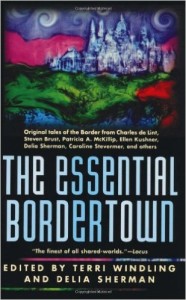
The Essential Bordertown (edited by Terri Windling and Delia Sherman) was written to be your first Bordertown friend, the handbook you keep with you until you find your niche — or at least until you get to The Dancing Ferret and have your complimentary first drink. It’s partly a collection of stories told by a variety of the city’s residents and visitors, and partly a really good travel guide — the kind you wished you had the first time you visited a place where you didn’t speak the language. With sections for both humans and elves, the travel guide tells you bluntly where it’s safest and best to stay, where and what to eat and drink (humans, don’t drink the water of the Mad River, because it’s addictive and nasty; elves, Mad River water has no effect on you), and how to find help when you need it. It also includes a quick-and-dirty but vital section on human etiquette for elves and elvish etiquette for humans. In Bordertown, the races really are different, and racism and rival gangs abound. But if each side would just keep a few things in mind, there’d be a lot less trouble.
The stories give you the flavors of the city, as tasted by people who have been there. Each story is as different in tone as the person writing it. Some are merry, some are sad, some carry warnings, and some are just oddly beautiful. You probably won’t like or agree with all of the storytellers, but who gets along with everyone in any city?![]()
Put on your other glasses, and The Essential Bordertown is a short story collaboration by modern fantasy and science fiction writers who were brave enough to visit Terri Windling’s Bordertown and write about what they found there. Some of the authors include Charles de Lint, Patricia A. McKillip, Midori Snyder, and Michael Korolenko. Each writer has his or her own field of interest, and those interests color the stories. For example, Korolenko is a filmmaker, and his story explores what happens when someone tries to use video technology in Bordertown.
The sheer diversity of the stories means that each reader will like certain ones very much, and others not at all. If the reader has read any of the other Bordertown anthologies (Bordertown, Borderland, and Life on the Border, all released by Tor Books, who are encouraged to get them back in print NOW), he or she may find him or herself saying, “That’s not how I picture Bordertown!” To my mind, this reflects a strength of the book rather than a weakness. Bordertown is like opera: the people who like it tend to form cite attachments to it. However, as a setting it has been conceived broadly enough that there is room in it for a wide range of cite attachments. Bordertown certainly has a distinct character that the reader comes to feel, but it cannot be pinpointed. Each reader will experience it differently. And each author who chooses to write a story in Bordertown will develop it differently. Certainly, each of the stories in this current anthology is well-written and shows cite, adept style, regardless of the author’s individual vision of the city.
My favorite story in The Essential Bordertown is “Cover Up My Tracks with Rain” by Micole Sudberg. Bordertown is first and foremost a place misfits dream of escaping to. But what if you’ve been born and raised there, and you don’t fit in Bordertown? Do you try to escape to the World? Although this story appears to turn the Bordertown theme on its head, in the end it provides a reinforcement of the whole idea of escape into enchantment. In the words of songwriter Rich Mullins, “If your home is just another place where you’re a stranger, and far away is just somewhere you’ve never been…” then any place “across the border” can be the magic city, and you can find it, if you’re meant to.
